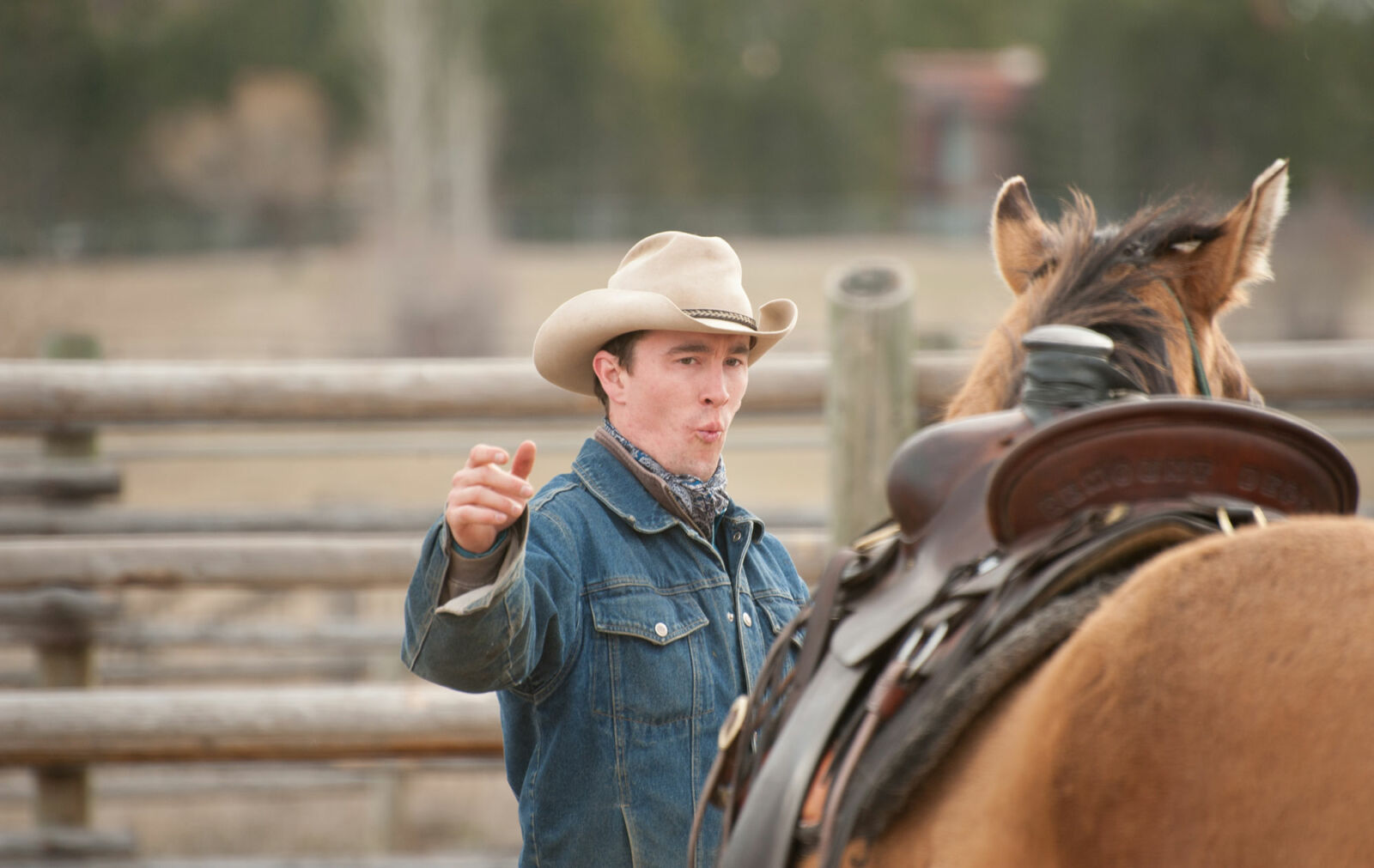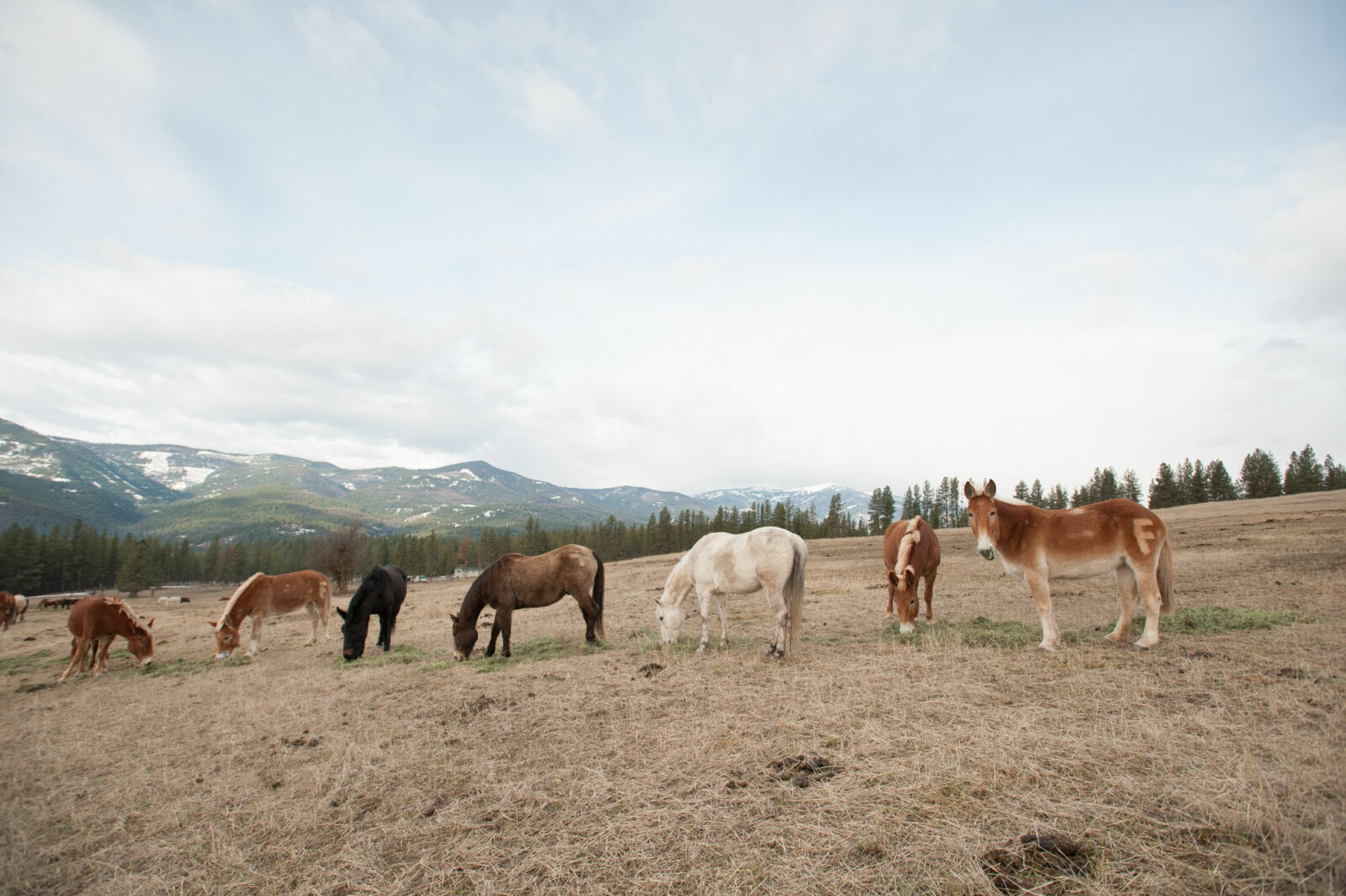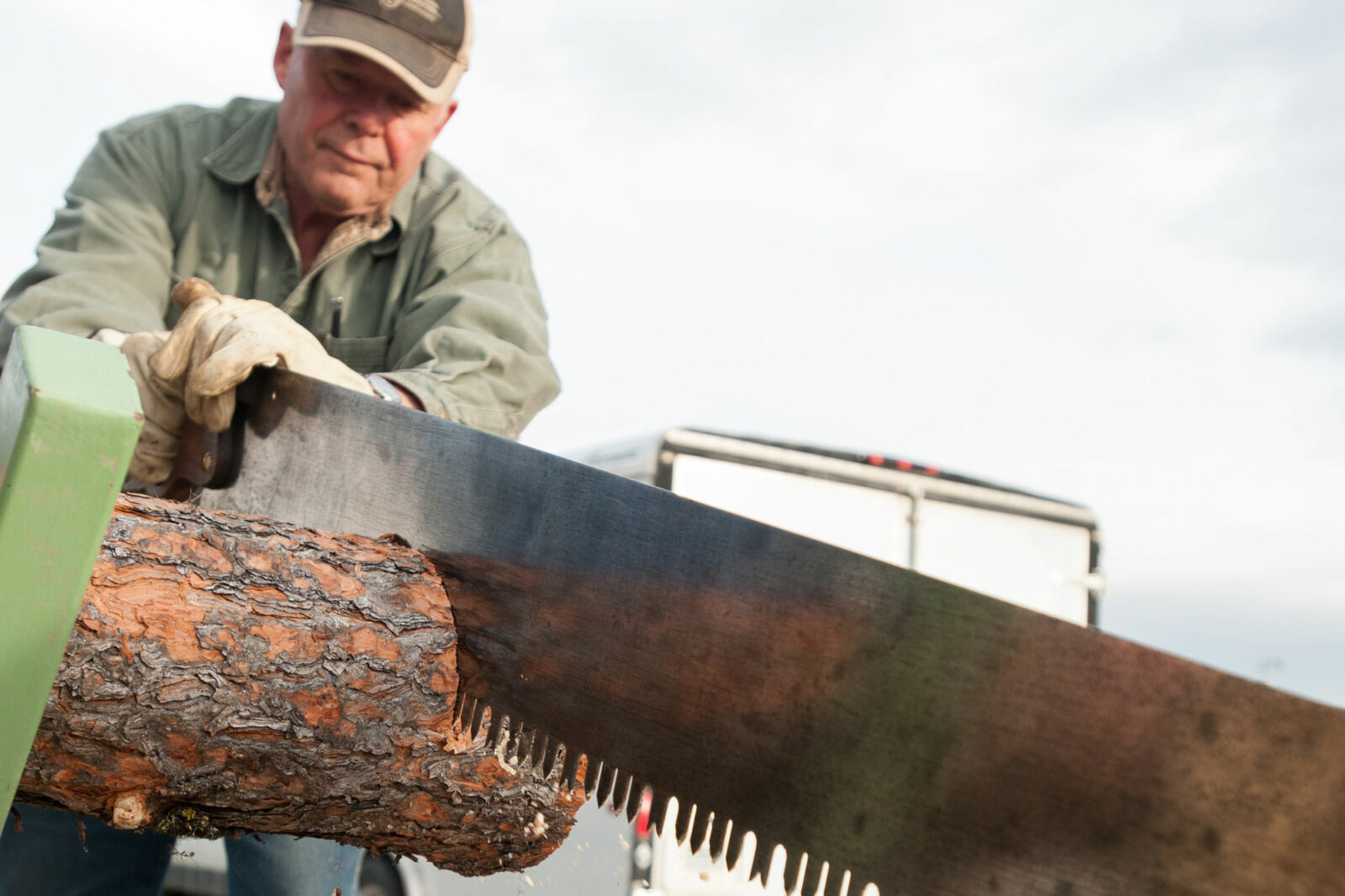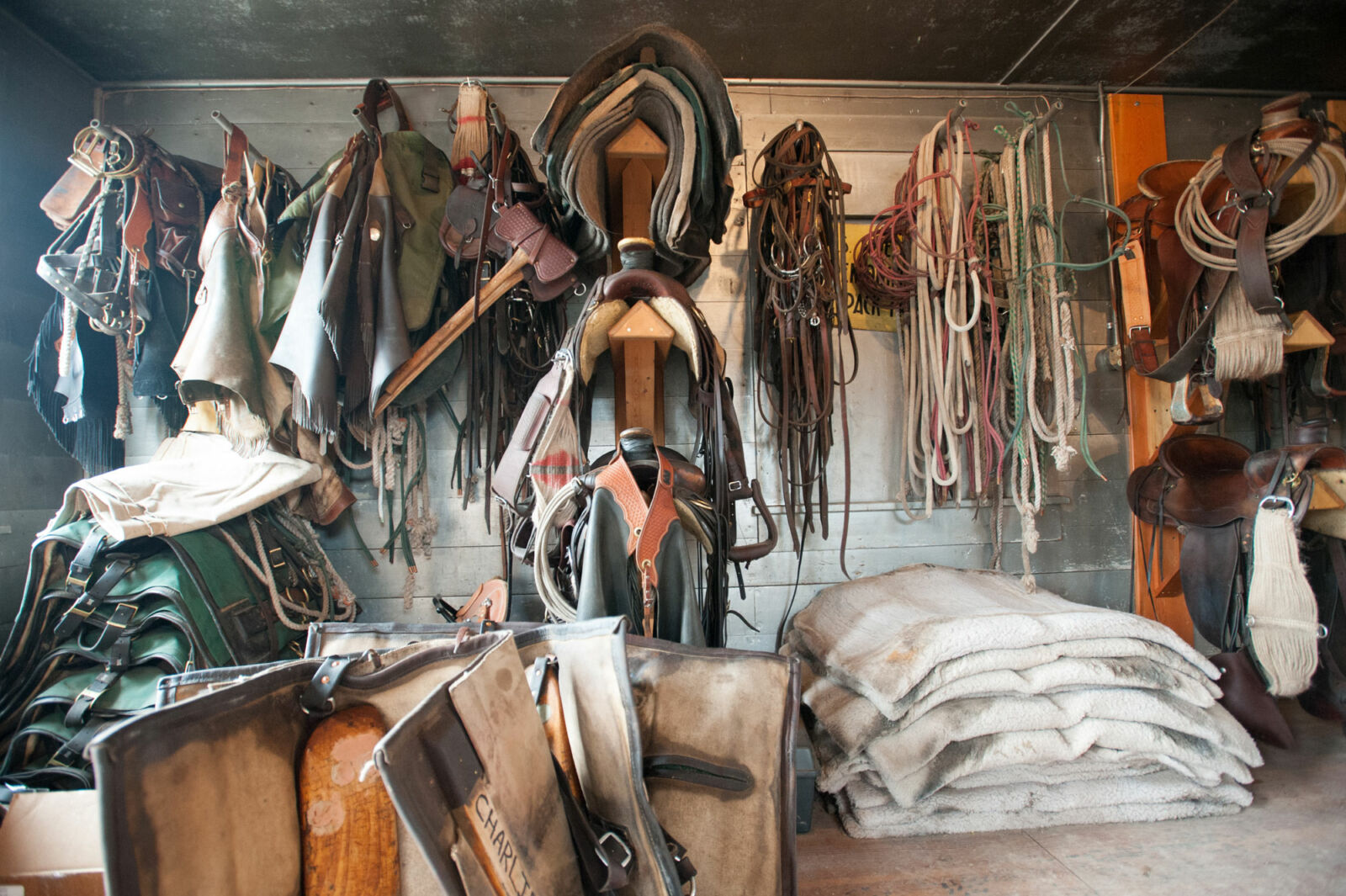My colleague Hannah and I are on Casey’s home turf, a 40-minute drive from our offices in Missoula, Montana. Brown stubbled grass and leafless cottonwoods stretch out under a pale blue sky on this cool April morning as we bounce up to the “Donkey Pasture.” We’d driven up to learn more about the Ninemile Remount Depot and Ranger Station where Casey works for the U.S. Forest Service as the Manager of the Wildlands Training Center and the Ninemile Pack Train.
Feeding Time
The “Ninemile’s” historic collection of buildings is part typical Forest Service ranger district, part tourist destination, and part working ranch. A standard complement of Forest Service employees works at the station—a silviculturist, District Ranger, trail crews, and others who ensure the District resources are maintained and the public is safe. But Casey and the other cowboys we see milling about have a very different role, one that exists only in this corner of western Montana.
More than 200 government-owned mules and horses board here each winter. These mules, and the horses that help wrangle them, make up the Northern Region pack train—a collection of pack animals used to maintain the vast Wilderness areas that stretch across Montana and North Idaho. Each summer, these mules are loaded with food, lumber, water, crosscut saws, and myriad other tools and packed into the Bob Marshall, the Scapegoat, the Great Bear, the Selway Bitterroot, and the other sprawling Wilderness areas managed by Region One of the Forest Service.
“That’s Big Mike,” Casey points to a huge brown mule. “Prozac, Hiram, Rudy, Bones, Preacher, Red, Ben,” he continues as we bounce across the pasture. Ranch hand Marc Pengali, stands on the back of a flatbed pickup truck slicing orange twine from rectangular bales of hay and chunking off bits of the green yellow alfalfa onto the ground. The line of animals stretches to the far end of the pasture. It’s feeding time and Marc and his young partner, Eli Indreland, are doling out rations in a tight choreography. The animals munch contentedly or nose up to our SUV to check out the strangers. Casey tells us it takes 400 tons of hay to feed the animals all winter. They raise about 320 tons on site during the summer, cutting, bailing, and storing it under an immense shed. The rest they buy.

Photo by Catherine L. Walters
The Mule Era
In the 1910s and 1920s, the Forest Service relied on horses and mules for nearly all aspects of managing its vast territory. Roads were few and far between, and the Great Burn of 1910 was still fresh in the young agency’s mind. Rangers rode horses across their huge districts and mules packed in fire-fighting tools, supplies, and rations for the growing wildland fire-fighting efforts that had become a primary focus of the Forest Service. In those early years, the agency relied on hiring the pack animals it needed from local farmers and ranchers, but by the late 1920s, tractors and trucks did most of the farm’s hauling, plowing, and haying, and quality animals were scarce. Recognizing a need for self-provision, the Region One office of the Forest Service leased a one-square mile, run-down ranch in the Ninemile Valley, and the Ninemile Remount Depot was born. Its primary goal: supplying the agency with a reliable supply of sturdy, mountain-ready mules and horses for fighting fires.

Photo by Catherine L. Walters
Three years later, the Forest Service purchased the ranch, and with help from the Civilian Conservation Corps, a New Deal program, the Remount Depot was transformed from a run-down work-in-progress into a shiny white-washed showpiece. The “CCC boys” worked hard and fast. Bunk houses, Ranger offices, tack sheds and a huge barn appeared almost overnight. Irrigation lines were dug, fences were built and whitewashed, and mules and horses were bred, housed, and trained for fire-fighting and other backcountry duties.
While mules and horses proved invaluable to the Forest Service during the 1920s and 30s, by the mid-1940s, the agency was ready to fight fires with more modern technology. A decade or so of successful experimenta¬tion and a sudden surplus of planes capable of hauling men and gear into remote mountainous terrain following World War II ushered in the era of smokejumpers. Mules still played an important role in wildland firefighting, they hauled out the gear smokejumpers used to extinguish fires, but on July 1, 1953, twenty-three years to the day after the Forest Service first leased the shabby ranch that became the Ninemile Remount Depot, Region One issued a press release that began:
“Services formerly rendered by the Forest Service Remount Depot at Ninemile will be considerably reduced commencing in July…in line with a program of economy aimed at reducing government expenditures.”
While smokejumpers and aviation-based firefight¬ing played a large role in the Remount’s loss of purpose, the post-war building boom helped too: houses required timber and timber required roads. By the mid-1950s, areas that were accessible only by mules and horses were now criss-crossed with miles and miles of roads. By the 1970s, pretty much the only areas on National Forests that didn’t have roads were Wilderness areas.
Today, land managers still need access to Wilderness for trail maintenance, bridge building, and fighting small wildfires, so the horses and mules that spend their winters at Ninemile are used almost exclusively for maintaining these remote, roadless spaces. Were it not for Wilderness, these animals, and perhaps more importantly, the skills needed to string a pack train and march into some of the most remote and rugged terrain in the U.S. would have likely vanished decades ago.

Photo by Catherine L. Walters
Sharpening, Setting, and Sawing
The sound of hammer striking metal ripples through the room. The air smells like WD-40 and metal shavings. A half-dozen folks stand upright behind long wooden racks, intent on the shiny metal saws affixed firmly to the tops of the handmade racks. We’ve discovered the crosscut saw sharpening class and are getting an introduction to another unique service that Ninemile offers.
In addition to wintering more than 200 mules and horses, Ninemile runs the Wildlands Training Center. The Center offers a series of Traditional Skills classes to agency professionals and hobbyists from across the country. The six students in this session—one of the weeklong crosscut saw sharpening classes throughout April—are a mix of Forest Service employees or contractors and everyday Americans. They’re here to learn how to maintain crosscut saws so they can clear Wilderness trails or cut firewood for their homes without the noise, stench, and danger of a chainsaw.
We get a quick lesson from Arden Corey, the class instructor. The saw’s large, jagged teeth cut across the wood’s grain, hence the “crosscut” name. Depending on the saw design, a group of sharp teeth alternate with the raker, a half-inch wide spout of metal notched in a v that chisels out the wood cut by the teeth. Each component needs to be skin-slicing sharp to operate as efficiently as possible. The tips of the raker are hammered and filed so that they’re five one-thousandths of an inch shorter than the teeth. The teeth, in turn, are “set” eight one-thou¬sandths of inch outside of the plane of the saw. This keeps the saw from binding in the log but also maintain efficien¬cy and ease of cutting. Too much set and the saw cuts too large a swath through the tree, wasting energy. Too little set and the saw binds in the log, disrupting the smooth rhythm of the sawyers.
While it’s Arden’s first year teaching the class, he’s definitely not new to crosscut sharpening. Wearing a waxed canvas apron, he moves about the class, helping the students with their saws. He learned how to sharpen crosscut saws from Warren Miller who literally wrote the book. Casey hands me a copy as we mill about, chatting with the students. Miller passed away suddenly this winter, a sad reminder of how important these classes, and their instructors, are for the agencies that manage Wilderness. Without the skills to properly sharpen a crosscut saw or string a pack mule—Ninemile offers both introductory and advanced packing classes—the Forest Service, the Park Service, and other public land agencies wouldn’t be able to clear trails, build bridges, and effi¬ciently fight small fires in remote areas.
There are a handful of old timers like Arden who have this knowledge, and the Forest Service sends many of its saws to them to sharpen during winter’s cold, dark months. But as they age and as recreational Wilderness use increases, there is a real need to teach a new generation of sharpeners and sawyers the intricacies of maintaining and operating these simple but effective tools.
“Without Wilderness, we wouldn’t be here,” Casey tells me on the phone prior to our first meeting. “You can’t use a chainsaw in the Wilderness, and you can’t drive there either, so the mules and the crosscut saws are integral to our ability to maintain these areas.”
Hannah and I get a turn bucking a log when the class heads outside to see how their saws perform. Tim Fetterer, a friendly Midwesterner from Indiana, lends us his. “That was my grandfather’s saw. He was a logger in Washington in the 1930s.” He grins, “It took me about 20 hours to clean the rust off of it, and it’s taken the better part of the week for me to sharpen it.” Other students nod in appreciation. There’s more than one grandfather’s saw in the class, shined and sharpened by a new generation of homestead-ers who purposefully eschew more modern technologies.

Photo by Catherine L. Walters
Tim’s grandfather’s saw works amazingly. The first pull slices through the reddish brown bark, and with each subsequent pass, we send small slivers of pale tan wood drifting through the air. In less than thirty seconds, a round disk of wood thunks to the ground. It’s a small tree—only about ten inches in diameter—but the saw’s efficiency and cutting power is impressive. I smile at memories of spending an hour swearing at a sputtering chainsaw, cleaning spark plugs, spilling chain lubricant, and dealing with last year’s water-fouled gasoline. A big part of me sees the appeal of the old way.
We accept the “nice job” and “there you go” accolades with a flush of mild embarrassment. We shake hands with the class members we’ve met—Sam Andrews, a quiet, steady Coloradan woman who works as a Forest Service contractor clearing trails; Bill Hardin, the Intel engineer from Oregon; Michael Raney, a gregarious Canadian from Saskatchewan; Jeremy Watkins, a young Forest Service trail boss based out of tiny Elk City, ID, and Corey Crone, who maintains a Youtube channel devoted to modern homesteading called “Wrangler Star” and from whom many of the attendees learned about the class. With this final exchange, we’re off to watch Casey “pack” a mule name Ruthie.
Mule Era Redux
It’s abundantly clear Casey has both packed a mule and taught scores of others how countless times before. Before he lifts a piece of gear or touches a saddle, he loads some grain into a green mesh sack and places it over Ruthie’s head. In an instant, she’s contentedly munching away on the oats and corn. With Ruthie occupied, Casey begins. First he brushes her flanks and then a fleece blanket free of dirt, pine needles, and other bits that could rub raw on a long pack into the Wilderness. The fleece blanket goes on first and then with a practiced expertise, he gently sets a forty pound “Decker” saddle on Ruthie, ex¬plaining not only how it works, but who invented it, when it became the standard mule packing saddle, and why. Half-hitch knots appear magically from the coils of rope he handles; leather straps pass through shining metal buckles, are cinched and cinched again.
To the uninitiated, it might seem arbitrary and un¬polished, but every movement and piece of equipment has a purpose—often more than one. Boxes full of gear are wrapped with a “manny,” a canvas sheet that Casey deftly folds into place creating a self-binding wrap that’s virtually waterproof. He ties it up in a series of binding hitches with 35 feet of rope, which can be used in camp to tie horses, set up an impromptu corral, or hang food from a tree. The canvas sheet becomes a ground cloth, a rain tarp, or a sun shade once the mule is unloaded for the night. In sixty short seconds, he’s hoisted the bundle onto the saddle and with a couple more magical half-hitches, the load is secure and ready, perched vertically along Ruthie’s right side, waiting for its mirror image to appear a few minutes later on her left. Almost every knot is quick release in the event of a spill—these mules travel through some of the most unforgiving country in the U.S.
Casey finishes the lesson with a short definitive declaration, “In horsemanship, the old way is the best way.” Based on what else we’ve learned at Ninemile, it seems this is true in more than just horsemanship. From dutch oven cooking, to axemanship and crosscut saw maintenance, to packing mules deep into the backcountry, the old ways are not only the best, they’re becoming hip again. The Wild¬lands Training Center’s classes are becoming more and more popular every year as a new generation of Wilderness rangers, rural and urban homesteaders, and niche Internet video producers connect the past to the present.
As we pile back into my car to drive back to the future— Missoula, the office, emails, and phone messages—Hannah wonders if they need someone to spend the summer at Ninemile, posting to Facebook, sending daily tweets, and starting a blog. I wonder if they need another Wilderness Ranger and how my wife will feel about my latest career fantasy.

